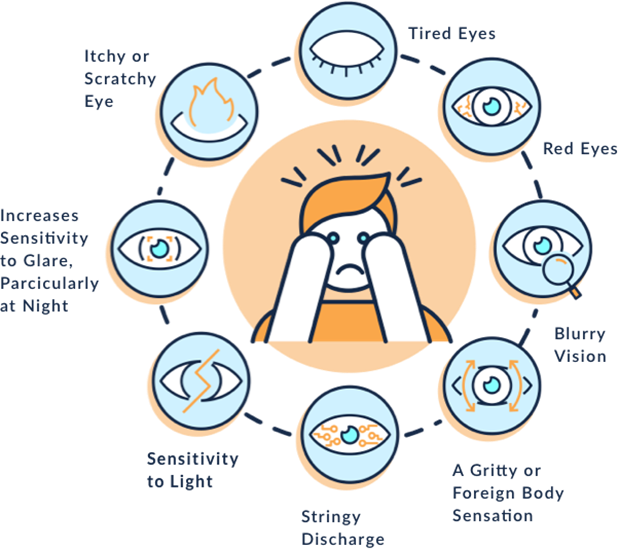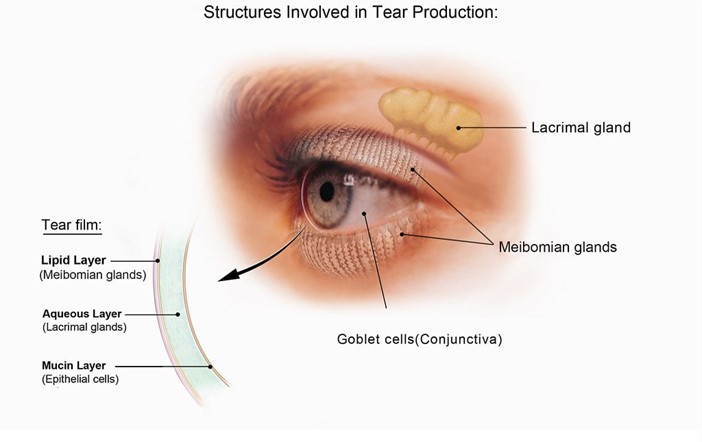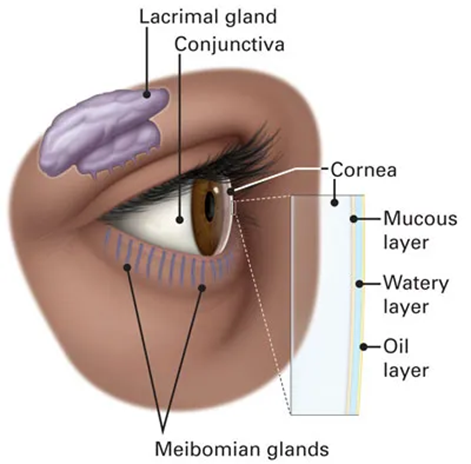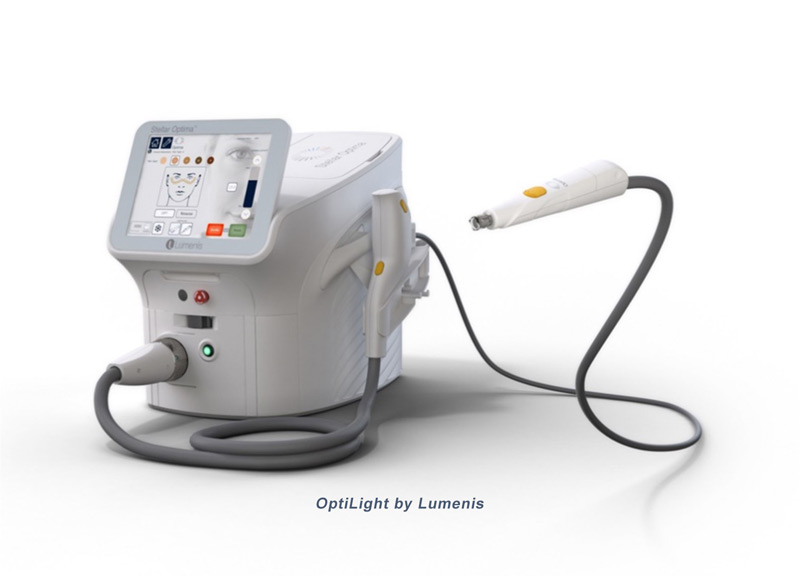Dry Eye Clinic
What is Dry Eye?
Dry eyes are uncomfortable and irritating! But what exactly is dry eye? Put simply, dry eye occurs when your eyes don’t produce or keep adequate lubrication to keep the ocular surface moist and comfortable.
There are two main causes why you may be experiencing dry eye symptoms. The first is known as aqueous deficiency dry eye—it happens when your eyes don’t produce enough tears. The second and more commonly known is the evaporative dry eye.
Evaporative dry eye occurs when there is an imbalance in the tear film. It means your natural tears are of insufficient quality and lack the proper chemical composition.
The tear film is made up of these distinct layers, lipid (surface oil) and muco-aqueous tear (mucin and aqueous tear). Each of these layers plays an important role in keeping the ocular surface protected and lubricated. The mucin layer spreads the tears over the eye’s surface. The water or aqueous layer keeps the eye hydrated, and the oil layer prevents the underlying aqueous tear from evaporating.
If any of these layers are out of balance, annoying and frustrating dry eye symptoms are the result. At in , we offer comprehensive diagnostic and treatment options. The newest procedural treatment option is the Intense Pulsed Light (IPL) with OptiLight by Lumenis.
Dry Eye Disease Symptoms?
Dry eye symptoms affect millions around the world. Left untreated, they progress to the disease state and start affecting people’s vision, quality of life and work productivity.
Common Dry Eye Symptoms
- Red, dry, burning and itchy eyes
- Light sensitivity
- Blurred or fluctuating vision
- Overly watery eyes
- Discomfort or pain with contact lenses
- Discomfort when wearing eye makeup

What Causes Dry Eye Disease?
Our Dry Eye Clinic specializes in identifying and treating the root causes of your dry eye disease (DED) using the most advanced technology. We follow evidence-based treatment protocols to manage and treat all ocular surface disease conditions.
In addition to Meibomian gland dysfunction, dry eyes can develop for many reasons, including:
- Age (a majority of people 40 and older experience symptoms of dry eyes)
- Gender (women are more likely to develop dry eyes due to hormonal changes)
- Medications (i.e. antihistamines, decongestants, blood pressure medications, and antidepressants can reduce tear production)
- Medical conditions (i.e. rheumatoid arthritis, diabetes, and thyroid problems)
- Environmental conditions (i.e. exposure to screen time, smoke, wind, and dry climates)
- Long-term use of contact lenses
- Refractive eye surgeries such as LASIK

What is MGD?
Meibomian gland dysfunction (MGD) is among the leading causes of dry eye disease and it affects millions of people around the world. Often reported symptoms are watery and burning eyes, fluctuating or blurry vision, and inability to wear contact lens or eye makeup. The most common type of MGD is obstructive MGD, which occurs when the glands become clogged, stopping the meibum from reaching the eye’s surface.

The meibomian glands secrete an oil called meibum. Meibum (oil), aqueous tear (watery layer), and mucin (mucus) make up the three layers of the tear film. The meibum/oil stabilizes the tear film and prevents it from evaporating too quickly. A healthy tear film is required to keep your eyes moist and comfortable.
Common cause of MGD?
Spending long hours on digital devices (not blinking enough), wearing contact lenses, and using eyelash extensions or false eyelashes can all contribute to developing MGD.
Certain medical conditions can also cause MGD, such as:
- High cholesterol levels
- Conjunctivitis
- Eyelid infections
- Eyelid inflammation (blepharitis, Demodex)
- Skin disease (acne, rosacea, atopic and seborrheic dermatitis)
Additionally, some medications can cause a reduction in meibum production, such as glaucoma medications, estrogen replacement therapies, and retinoids commonly found in acne medication and anti-aging creams.
Treatment Options
The first step is to perform a comprehensive baseline dry eye exam. It is necessary to determine the causes of a patient’s ocular surface symptoms and to test how well the current tear film is functioning in protecting the patient’s eyes. Many technological advancements have occurred in both diagnosing and treating dry eye disease, therefore patients need to understand why each treatment is prescribed.
At , our optometrists are well-known and respected dry eye experts and educators. A customized treatment plan is formulated for each dry eye patient, detailed explanations and steps are reviewed with the patient before treatment begins. Our doctors are committed to helping you to find the right solution.
- OptiLight IPL (intense pulse light therapy) IPL treatment with OptiLight by Lumenis is the newest treatment option, is among one of the first practices in the world to provide this for our patients.
- Lid margin hygiene to encourage better oil gland production
- Discussion of supplements that may be beneficial
- Possible prescription eye drop medication
- Amniotic membrane technology
- Moist Heat Eye Compress
- Punctal Plugs

What is OptiLight?
OptiLight by Lumenis is a light-based, non-invasive treatment done around the eyes region to treat some of the underlying inflammation conditions that cause dry eye symptoms. It is the first and only IPL (Intense Pulsed Light) treatment that is FDA-approved for dry eye management.
The treatment is safe, gentle, and is backed by more than 20 clinical studies.
How Does it work?
OptiLight uses precise pulses of light to reduce the inflammation that is typically associated with dry eye disease and improved meibomian glands’ functions.
This application can significantly help relieve dry eye symptoms, and it offers other benefits:
- Increasing tear break-up time
- Reducing the amount of Demodex mites and bacteria living around your eyes
- Eliminating weak blood vessels that contribute to the inflammation cycle and Rosacea
- Improving meibomian gland functions and long-term protections
What To Expect
Length Of Your Treatment
The initial treatment requires 4 sessions scheduled 3-4 weeks apart. Many patients report increased symptom relief after each session.
Quarterly maintenance IPL treatments are recommended for patients who suffer from a chronic ocular surface disease, such as:
- Ocular and facial rosacea
- Frequent Styes
- Dry eye disease associated with a systemic and auto-immune disease
- Demodex
- Blepharitis
During Your Treatment
This treatment is non-invasive and gentle. Doctors at provide the treatments. During the treatment, the doctor will apply a cool coupling gel on the treatment area and cover your eyes with either cornea or IPL shields.
As light is applied to the skin, you may experience a warm sensation. The treatment is gentle with minimum discomfort. The treatment itself takes about 15 minutes. Patients are asked to come with a clean face, no makeup for women, and a clean shave for men.
After Your Treatment
A course of treatment typically includes 4 sessions spaced 3–4 weeks apart. When the sessions are finished, we will work with you to determine the best schedule for maintaining your results. Usually, we see patients for maintenance every 3-4 months.
OptiLight by Lumenis is well-tolerated and most people can resume their normal activities immediately following treatment. Most women can apply their makeup after treatment. You might experience some redness or a warm sensation in the treatment area, but this usually resolves in less than 48 hours.




Will OptiLight work for me?
Dry eye disease is a complex and chronic disease with many underlying causing factors. Schedule a comprehensive dry eye exam with our experienced doctors and we will help determine if the IPL treatment with OptiLight is the right treatment for you.
